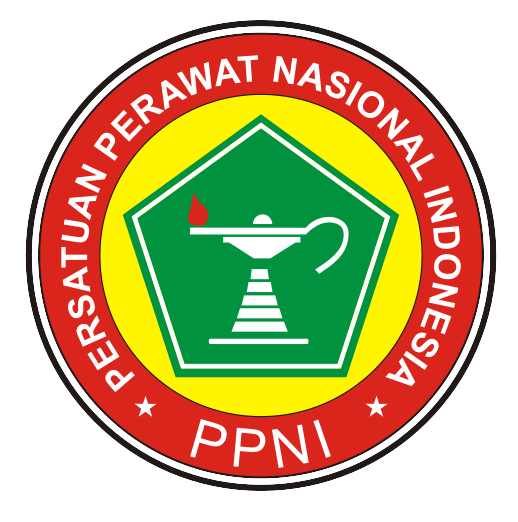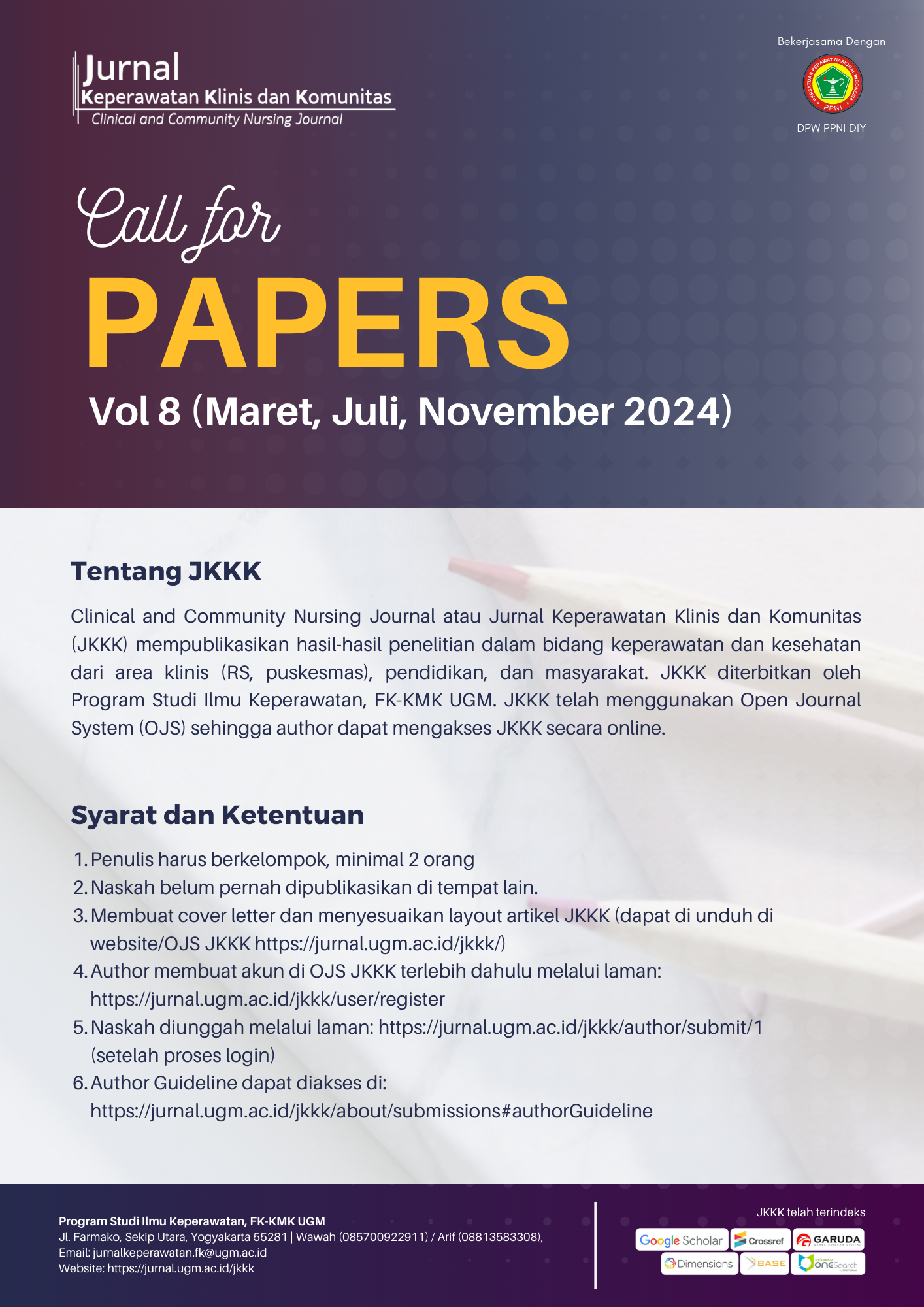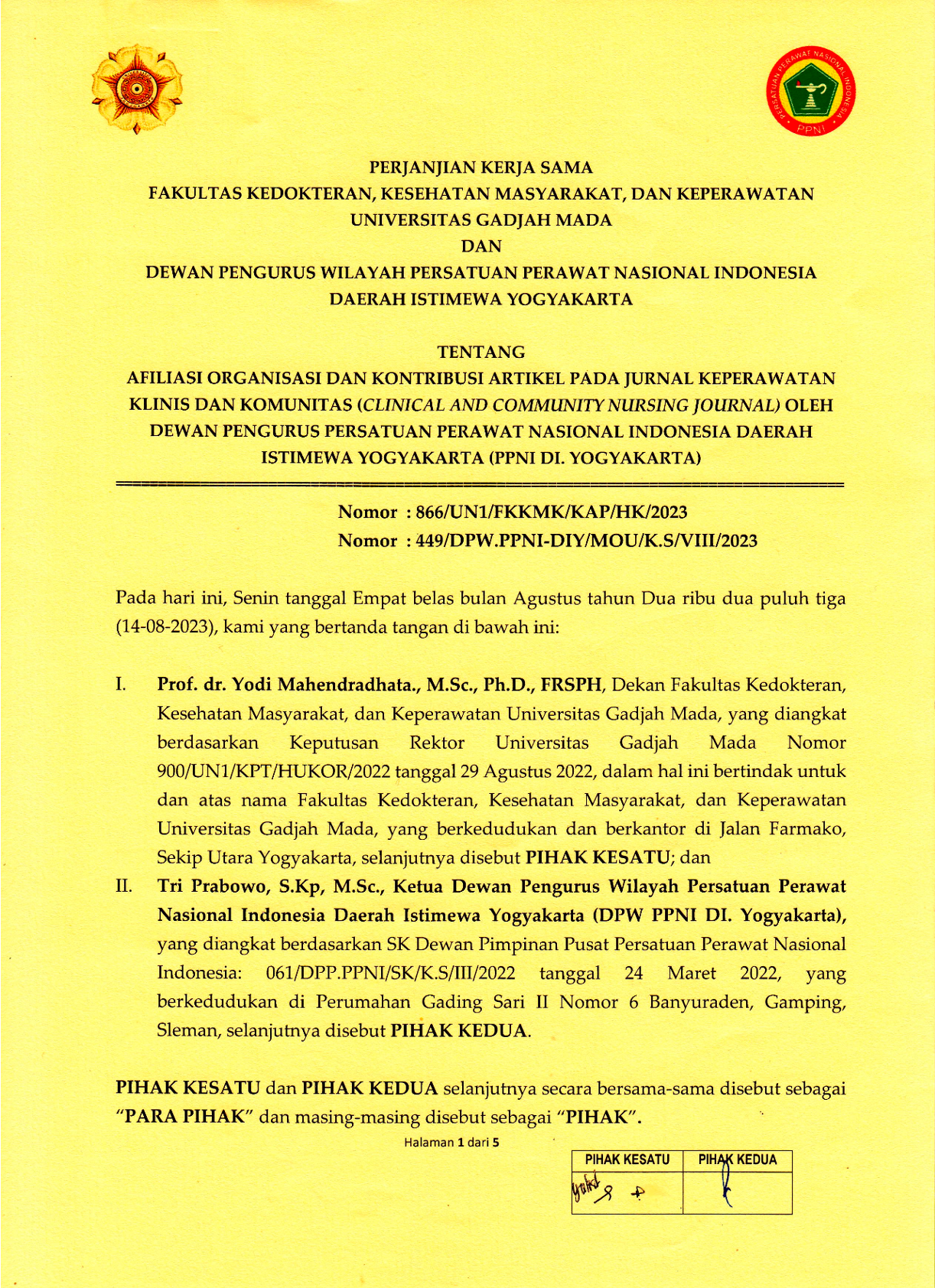Implementasi Telehealth dalam Meningkatkan Perawatan Paliatif pada Pasien Kanker di Era 4.0: Scoping Review
Indy Susanti(1), Istiqomah Nur Khasanah(2*), Arifin Triyanto(3)
(1) Program Studi Magister Keperawatan, Fakultas Kedokteran, Kesehatan Masyarakat, dan Keperawatan, Universitas Gadjah Mada Rumah Sakit Umum Daerah dr. Zainoel Abidin Banda Aceh
(2) Program Studi Magister Keperawatan, Fakultas Kedokteran, Kesehatan Masyarakat, dan Keperawatan, Universitas Gadjah Mada Program Studi Keperawatan, Fakultas Ilmu Kesehatan, Universitas 'Aisyiyah Yogyakarta
(3) Departemen Keperawatan Medikal Bedah, Fakultas Kedokteran, Kesehatan Masyarakat, dan Keperawatan, Universitas Gadjah Mada
(*) Corresponding Author
Abstract
Background: Sustainable palliative care toward advanced stadium cancer is provided by physical, mental, and psychosocial approach. In the 4.0 era along with recent COVID-19 pandemic, the use of telehealth for public service, including for patient with cancer, has increased.
Objective: To identify the implementation of telehealth in improving the palliative care of patient with cancer in the 4.0 era.
Method: This research was tracing the results of scientific publications using PRISMA flow diagrams. The article selection process was carried out by identification and screening. The searching keywords included Population (cancer patient), Intervention (telehealth OR e-health OR telemedicine OR telenursing OR digital health intervention), Comparison (not applicable), Outcome (improve palliative care in 4.0 era) in several databases, i.e. Google Scholar, Willey Online, Sage, PubMed, BMJ, and Science Direct. Then the articles were selected based on the title, type of article, abstract, and content according to the inclusion and exclusion criteria. Inclusion criteria included topic suitability, published in 2017-2022, in English, open access, and research article.
Outcome: Most of the telehealth services were done through mobile applications and website-based consultations. The use of telepalliative showed a positive effect on improving patient self-efficacy, sense of security, patient involvement in care, effectiveness of symptom management, supporting remote care, facilitating access to health professionals. In emergency situations when there was a worsening condition, it was still necessary to carry out direct examination and/or treatment.
Conclusion: Telehealth needs further development and research to determine its level of frequency and efficiency to support health services, especially in the field of palliative care.
ABSTRAK
Latar belakang: Perawatan paliatif berkelanjutan diberikan secara fisik, mental, dan psikososial pada pasien kanker dengan stadium lanjut. Di era 4.0 yang bersamaan dengan adanya pandemi COVID-19, telah meningkatkan penggunaan telehealth dalam pelayanan kesehatan, termasuk pada pasien kanker.
Tujuan: Mengetahui implementasi telehealth dalam meningkatkan perawatan pasien kanker di era 4.0.
Metode: Penelitian ini dilakukan melalui penelusuran hasil publikasi ilmiah, menggunakan alur diagram PRISMA. Proses pemilihan artikel dilakukan dengan identifikasi dan skrining. Penelusuran kata kunci yang dilakukan, meliputi: Population (cancer patient), Intervention (telehealth OR e-health OR telemedicine OR telenursing OR digital health intervention), Comparison (tidak ada), dan Outcome (improve palliative care in 4.0 era) pada Google Schoolar, Willey Online, Sage, PubMed, BMJ, dan Science Direct. Kemudian artikel diseleksi berdasarkan judul, jenis artikel, abstrak, dan konten sesuai dengan kriteria inklusi dan eksklusi. Kriteria inklusi meliputi kesesuaian topik, diterbitkan tahun 2017- 2022, berbahasa Inggris, open access, dan research article.
Hasil: Mayoritas telehealth dilakukan melalui aplikasi seluler maupun konsultasi berbasis website. Pemanfaatan telepaliatif menunjukkan efek positif terhadap peningkatan efikasi diri pasien, rasa aman, keterlibatan pasien dalam perawatan, efektivitas manajemen gejala, pendukung perawatan jarak jauh, dan mempermudah akses kepada profesional kesehatan. Dalam situasi darurat, ketika kondisi memburuk yang membutuhkan konsultasi dan perawatan secara langsung, maka tetap perlu dilakukan pemeriksaan dan/atau perawatan secara langsung.
Simpulan: Penggunaan telehealth perlu terus dikembangkan dan diteliti lebih lanjut, untuk mengetahui tingkat frekuensi dan efisiensi pemanfaatannya, dalam rangka mendukung pelayanan kesehatan, khususnya di bidang perawatan paliatif.
Keywords
Full Text:
PDFReferences
- Agarwal R & Epstein AS. The Role of Palliative Care in Oncology. Seminars in Interventional Radiology. 2017; 34: 307–312. DOI: https://doi:10.1055/s-0037-1608702.
- Bonsignore L, Bloom N, Steinhauser K, Nichols R, Allen T, Twaddle M, et al. Evaluating The Feasibility and Acceptability of A Telehealth Program in A Rural Palliative Care Population: Tap Cloud for Palliative Care. Journal of Pain and Symptom Management. 2018; 56 : 7–14. DOI: https://doi:10.1016/j.jpainsymman.2018.03.013.
- Tang M & Reddy A. Telemedicine and Its Past, Present, and Future Roles in Providing Palliative Care to Advanced Cancer Patients. Cancers (Basel). 2022; 14. DOI: https://doi:10.3390/cancers14081884.
- Hancock S, Preston N, Jones H, & Gadoud A. Telehealth in Palliative Care is Being Described But Not Evaluated: A systematic Review. BMC Palliative Care. 2019;18. DOI: https://doi:10.1186/s12904-019-0495-5.
- Bakitas M, Cheville AL, Mulvey TM, Peppercorn J, Watts K, Dionne-Odom JN. Telehealth Strategies to Support Patients and Families Across The Cancer Trajectory. American Society of Clinical Oncology Educational Book. 2021; 413–422. DOI: https://doi:10.1200/edbk_320979.
- Ritchey KC, Foy A, McArdel E, Gruenewald DA. Reinventing Palliative Care Delivery in The Era of COVID-19: How Telemedicine Can Support End of Life Care. American Journal of Hospice and Palliative Medicine. 2020; 37: 992–997. DOI: https://doi:10.1177/1049909120948235.
- Adhikari SD, Biswas S, Mishra S, Kumar V, Bharti SJ, Gupta N, et al. Telemedicine as An Acceptable Model of Care in Advanced Stage Cancer Patients in The Era of Coronavirus Disease 2019 - An Observational Study in A Tertiary Care Centre. Indian Journal of Palliative Care. 2021; 27: 306–312. DOI: https://doi:10.25259/ IJPC_45_21.
- Schuit AS, Holtmaat K, Lissenberg-Witte, BI, Eerenstein SEJ, Zijlstra JM, Eeltink C, et al. Efficacy of The eHealth Application Oncokompas, Facilitating Incurably Ill Cancer Patients to Self-Manage Their Palliative Care Needs: A randomized Controlled Trial. The Lancet Regional Health - Europe. 2022; 18: 1–11. DOI: https:// doi:10.1016/j.lanepe.2022.100390.
- Chan ZY, Lim CF, Leow JL, Chium FY, Lim SW, Tong CHM, et al. Using The Technology Acceptance Model to Examine Acceptance of Telemedicine by Cancer Patients in An Ambulatory Care Setting. Proceedings of Singapore Healthcare. 2022; 31: 201010582211045. DOI: https://doi:10.1177/20101058221104578.
- Hoek PD, Schers HJ, Bronkhorst EM, Vissers KCP, Hasselaar JGJ. The Effect of Weekly Specialist Palliative Care Teleconsultations in Patients with Advanced Cancer -A Randomized Clinical Trial. BMC Medicine. 2017; 15: 1–10. DOI: https://doi:10.1186/s12916-017-0866-9.
- Caraceni A, Pellegrini C, Shkodra M, Zecca E, Bracchi P, Lo Dico S, et al. Telemedicine for Outpatient Palliative Care During COVID-19 Pandemics: A Longitudinal Study. BMJ Supportive & Palliative Care. 2022; 1–7. DOI: https://doi:10.1136/bmjspcare-2022-003585.
- Rygg LØ, Brataas HV, Nordtug B. Oncology Nurses’ Lived Experiences of Video Communication in Follow- up Care of Home-living Patients: A Phenomenological Study in Rural Norway. European Journal of Oncology Nursing. 2021; 52. DOI: https://doi:10.1016/j.ejon.2021.101955.
- Viitala A, Åstedt-Kurki P, Lehto JT, Palonen M. Online Follow-up with A Mobile Device Improves Incurable Cancer Patients’ Coping – A Qualitative Study. European Journal of Oncology Nursing. 2021; 55. DOI: https:// doi:10.1016/j.ejon.2021.102047.
- Bauer EH, Schultz ANØ, Brandt F, Smith AC, Bollig G, Dieperink KB. Protocol for An Integrative Review: Patient and Families’ Perspectives on Telehealth in Palliative Care. BMJ Open. 2022; 12(9). DOI: https://doi. org/10.1136/bmjopen-2022-062723.
Article Metrics
Refbacks
- There are currently no refbacks.
Copyright (c) 2023 Indy Susanti, Istiqomah Nur Khasanah, Arifin Triyanto

Jurnal Keperawatan Klinis dan Komunitas (Clinical and Community Nursing Journal)
collaborates with DPW PPNI DIY
![]()
Jurnal Keperawatan Klinis dan Komunitas (Clinical and Community Nursing Journal) is licensed under a Creative Commons Attribution-ShareAlike 4.0 International License.




